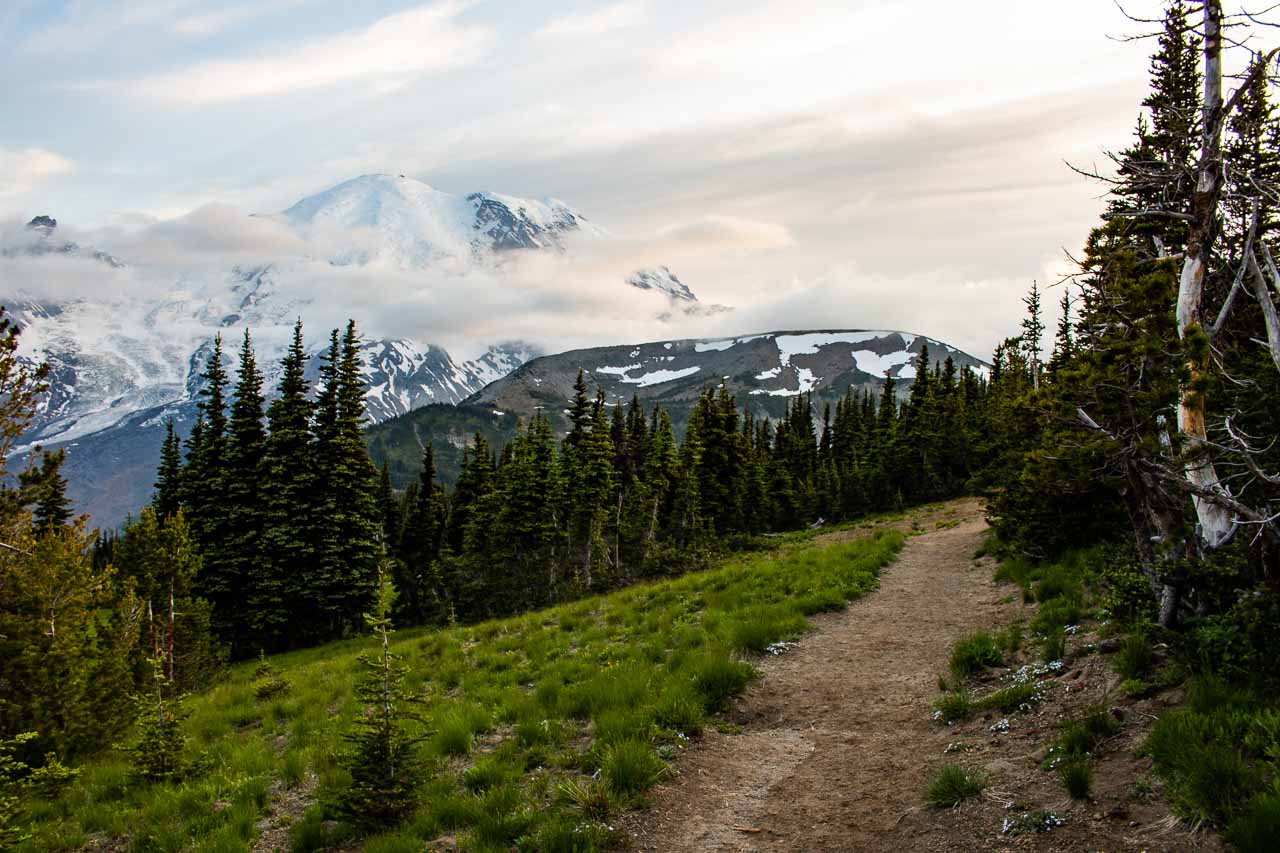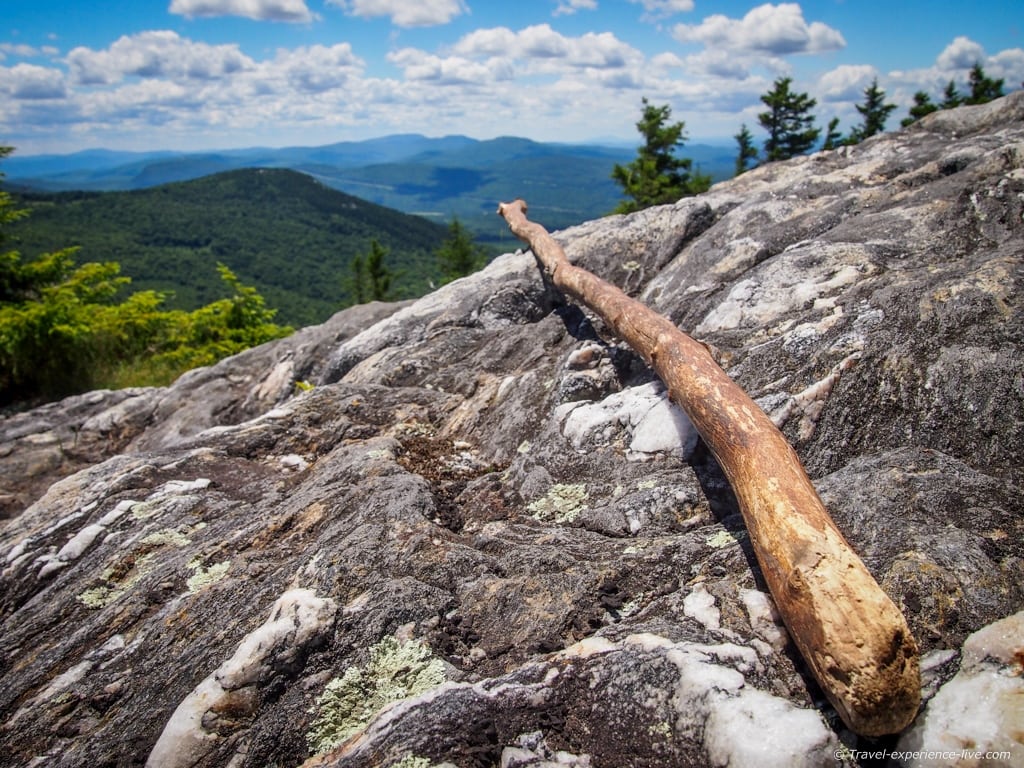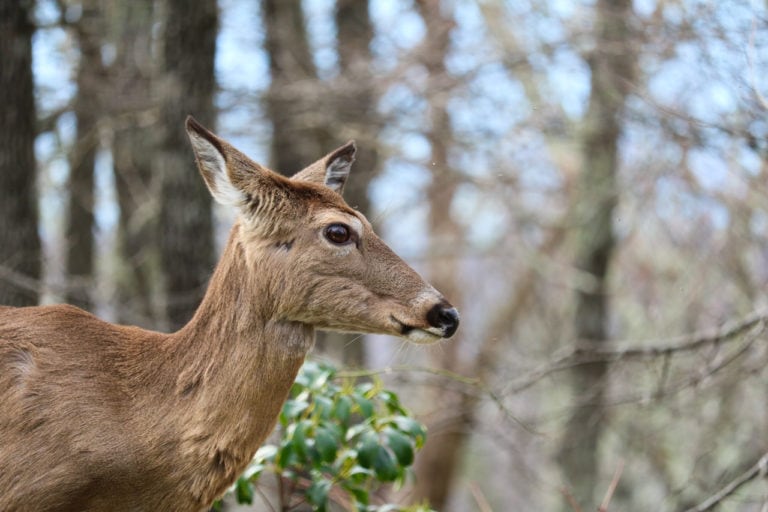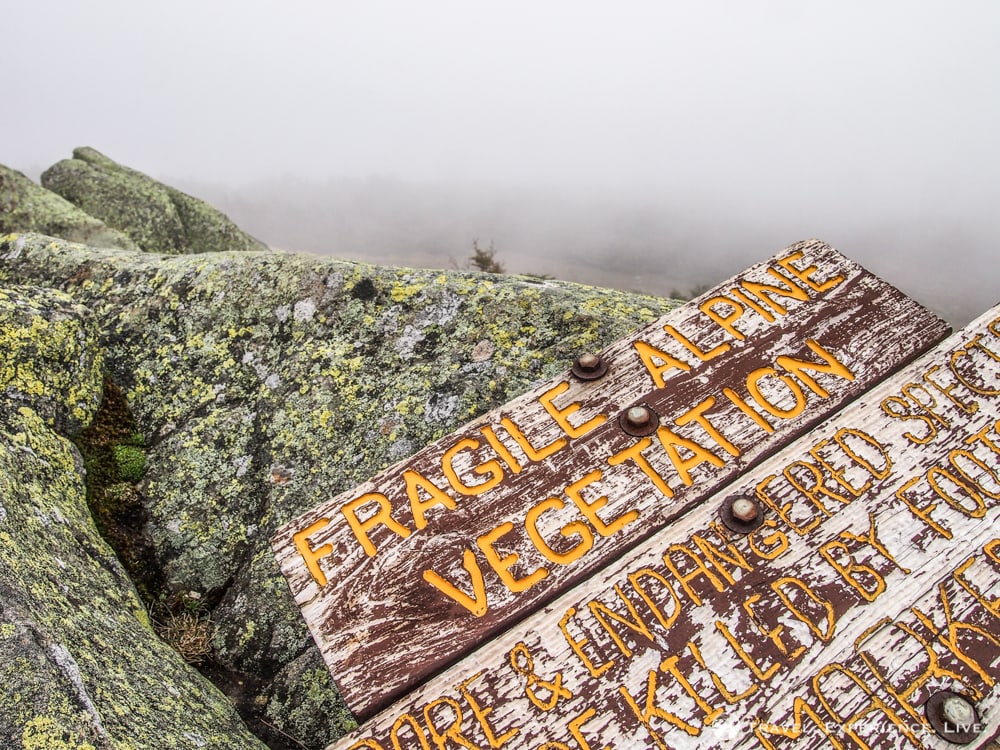15 Top Things to Do in Mount Rainier National Park
Rising 14,410 feet toward the heavens, Mount Rainier dominates the landscape in all of western Washington State, and is even visible as far south as Portland, Oregon. This mighty mountain is so prominent that it’s an integral part of the skyline of Seattle (on clear days).
The namesake of Mount Rainier National Park, one of the greatest national parks of the West, Mount Rainier is an active volcano. With more than 25 glaciers, it’s the most glaciated mountain in the lower 48 states.
Rainier is also the highest peak in the entire Cascade Range, which also includes other volcanoes like Mount St. Helens and Mt. Hood. Its summit is often shrouded in clouds, but on those rare blue-sky days, it’s a sensational sight.
In this post, I’ll talk about the top things to do in Mount Rainier National Park in summer, including activities and attractions in all four of the park’s main areas.
- Longmire – historic district in the southwestern corner of the park.
- Paradise – most popular area in Mount Rainier National Park, featuring wildflowers, waterfalls and amazing views.
- Ohanapecosh – in the park’s southeastern corner, boasting pristine old-growth forest, hot springs and waterfalls.
- Sunrise – the highest point in the national park accessible by vehicle, epic hiking and panoramic views of the Mountain.
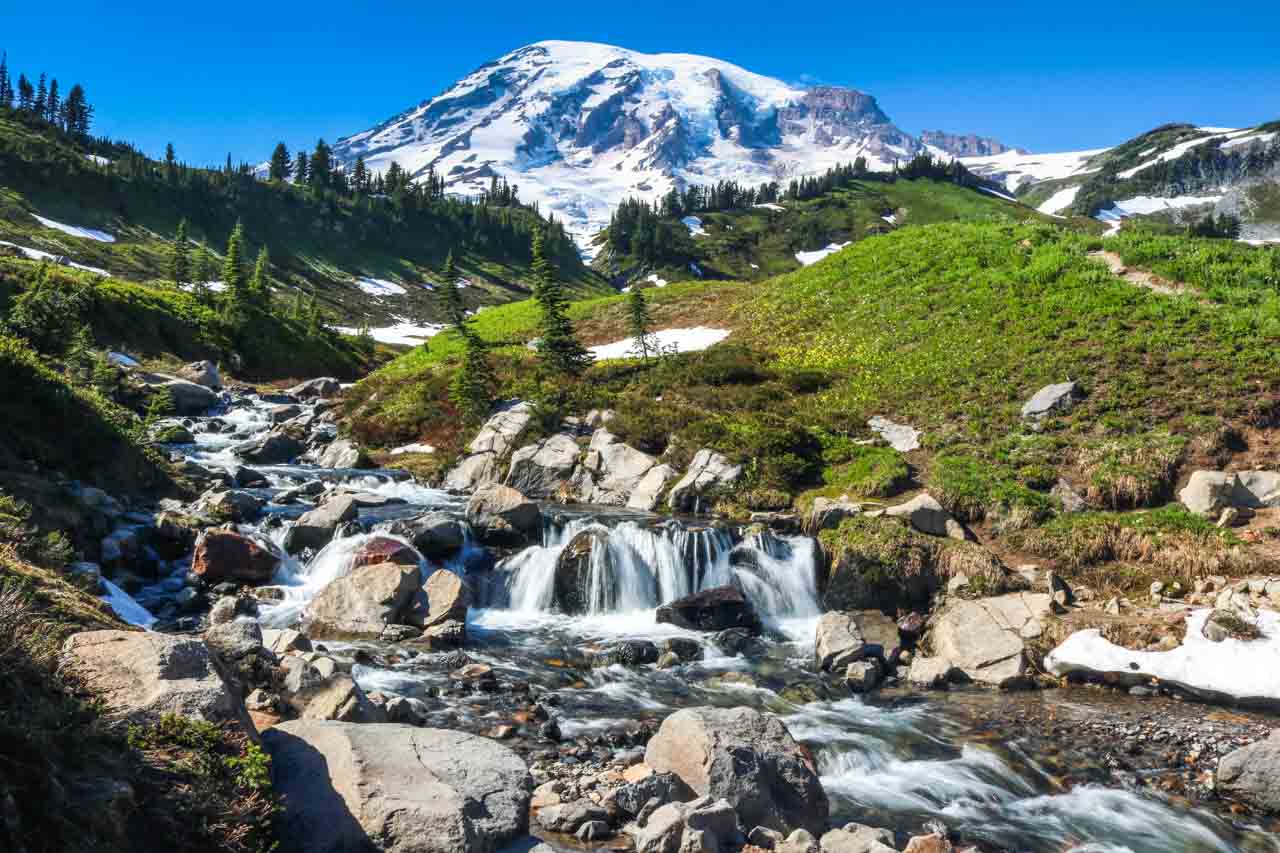
This post about the top things to do in Mount Rainier National Park post contains affiliate links. You can read more about our Terms of Use / Disclosure here.
Top Things to Do in Mount Rainier National Park in Summer
The following Mount Rainier National Park attractions are at their peak in summer, which is a rather short season in this high-elevation region. In fact, the best summer weather is limited to the period from mid-July to mid-August.
One of the most visited Pacific Northwest national parks, Mt. Rainier National Park is also a great destination in fall, though. Come September, the mountain’s slopes and valleys take on all kinds of colors, from yellows to oranges and reds.
When you visit Mount Rainier National Park in summer, this is what your itinerary might look like.
Note, though, that to do all of these Mount Rainier activities you’ll need two full days at the very least. If you only have one day at Mount Rainier, I recommend focusing on the Longmire and Paradise areas.
The following things to do in Mount Rainier National Park are listed in a counterclockwise direction, starting at the Nisqually Entrance. You are, of course, free to explore as you please.
Visit Longmire Historic District
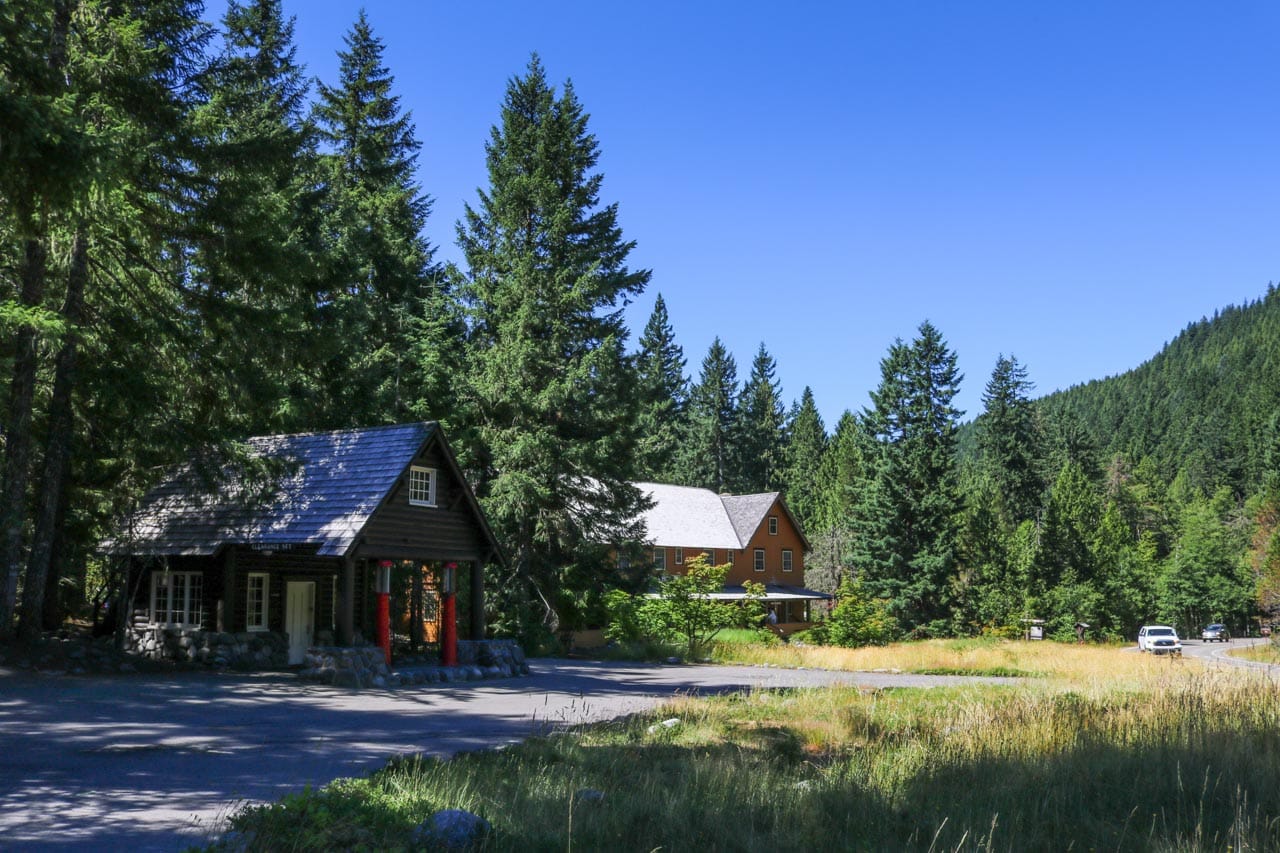
When Mount Rainier National Park was established in 1899—the fifth oldest of all U.S. national parks—, Longmire was the park’s headquarters.
The former homestead of James Longmire, nowadays the buildings house the Longmire Museum, the Longmire Wilderness Information Center and the National Park Inn. When you enter the park via the Nisqually Entrace, as many people do, this will be your first stop.
Get Close to a Glacial River on the Carter Falls Trail
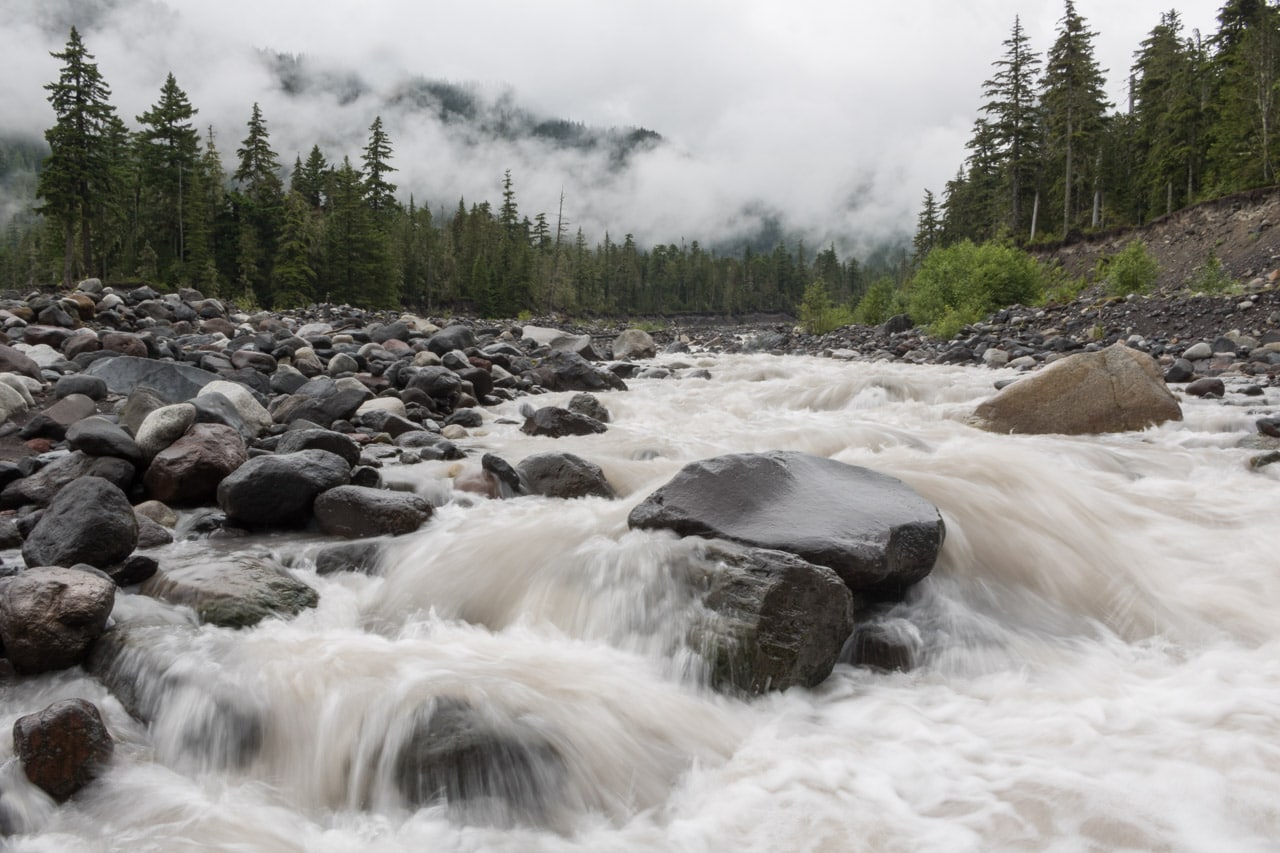
While the hike to Carter Falls is definitely worth it, if you don’t feel like a long hike here (there are plenty of other Mount Rainier National Park hiking trails to choose from later), you can just walk a short distance down into the wash toward the Nisqually River. The trailhead is just south of Cougar Rock.
Depending on the season, this glacial river is either a small stream or a raging river. In summer, when snow is melting non-stop at the higher elevations, the Nisqually is usually a fast-flowing river.
Follow the Carter Falls Trail across the riverbank and -bed toward a bridge. You’ll be really close to the wild waters here, so pay attention. The rocks near the river are slippery.
It’s a fantastic view, though, no matter the weather conditions. On a sunny day, Mount Rainier will tower in the background, while clouds bring moodiness and drama to the valley.
See a Waterfall Rainbow at Narada Falls
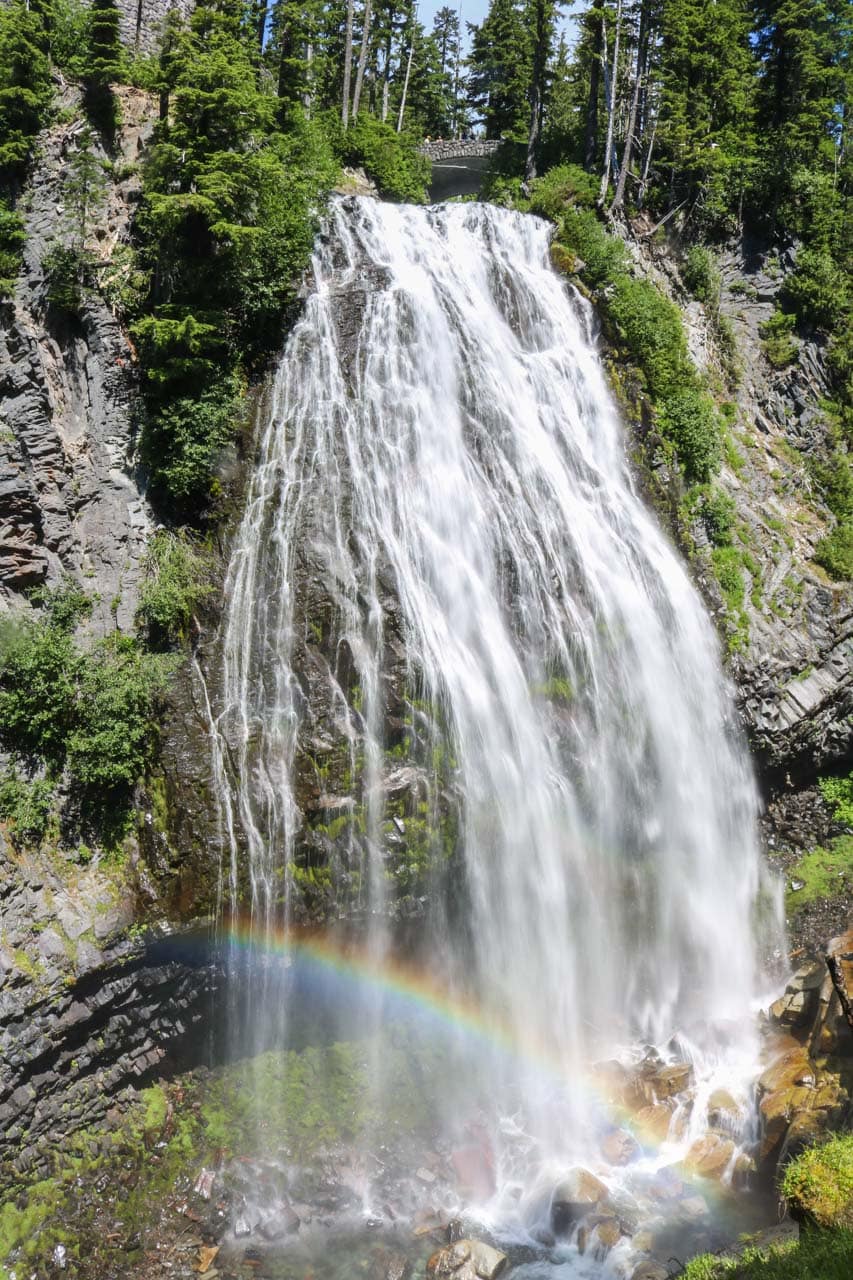
There are several beautiful waterfalls in the Longmire area, some of which are located near the road. One of the most spectacular waterfalls in Mount Rainier National Park is Narada Falls, which actually is just below Paradise.
You can get a fantastic view of this massive waterfall from a viewpoint that’s reached on a short trail from the road. If you’re lucky and it’s a sunny day, you may see a (double) rainbow shimmering at the falls.
Hike the Amazing Skyline Trail at Paradise

Without question one of the best places to visit in Mount Rainier National Park, the Skyline Trail is nothing short of epic.
This 5.5-mile round-trip hike starts at the Jackson Visitor Center at Paradise, just behind the beautiful historic Paradise Inn, climbing 1,700 feet to well above the tree line. In summer, this is where you need to be for wildflowers at Mount Rainier.
You’ll walk through gorgeous alpine meadows filled with all kinds of flowers, including Indian paintbrush, lupines and avalanche lilies.
Another major highlight on this hike is Panorama Point, which offers breathtaking panoramic views of the Cascade Range. The vista includes several other volcanoes, such as Mount Adams and even Mt. Hood all the way to the south.
It takes about 4 hours to complete this phenomenal hike. It’s one of my absolute favorite day hikes, ever, and definitely one of the best day hikes in Mount Rainier National Park.
Mount Rainier hiking doesn’t get any better than this.
Tip: If you’re looking for a multi-day hike in Mount Rainier, the Wonderland Trail is one of the America’s best national park backpacking trips!
Admire Glorious Myrtle Falls
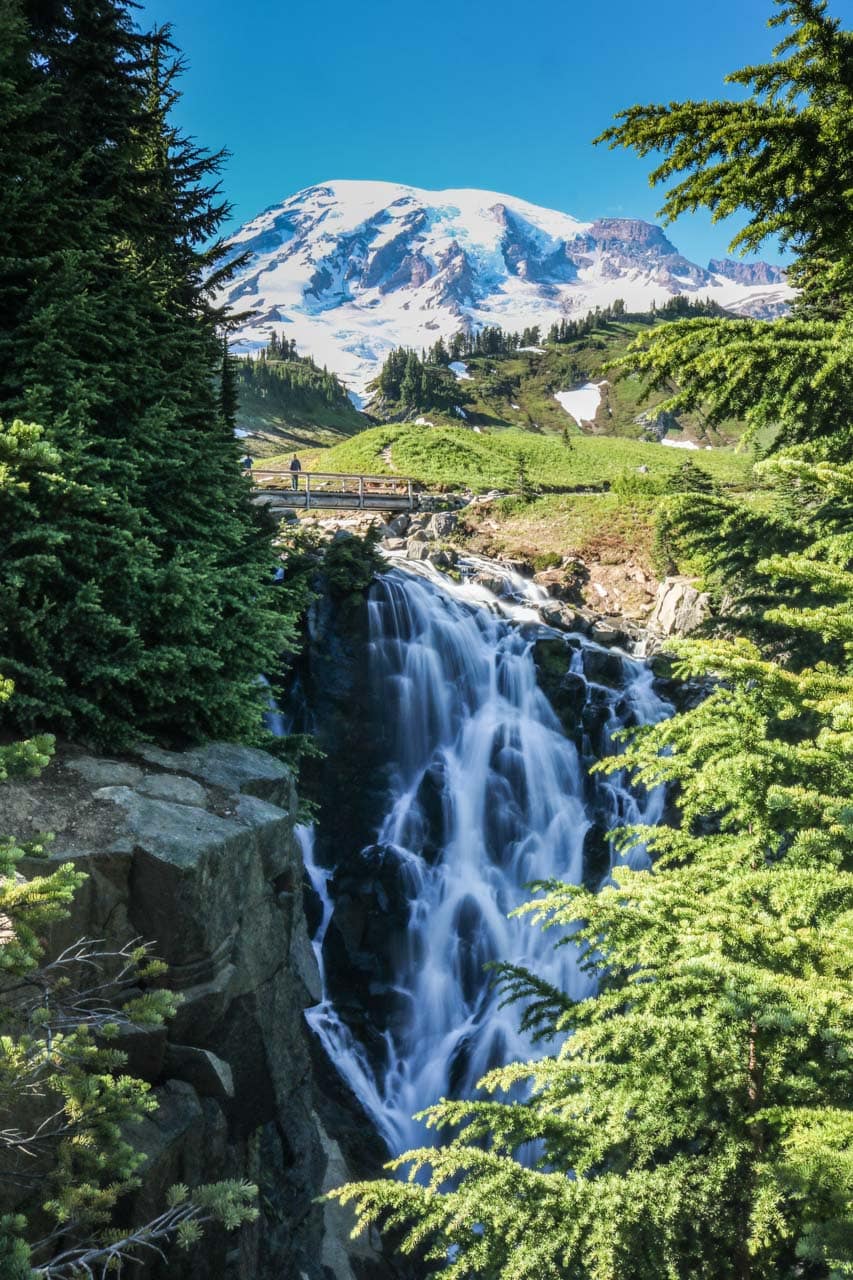
When you hike the Skyline Trail in a clockwise direction, you’ll save Myrtle Falls for a last reward. And what a treat it is!
A popular spot among photographers, Myrtle Falls in Paradise Park tumbles into a steep canyon, which would make for a beautiful view as it is.
What makes this so extraordinary, however, is the stunning background composed of glorious wildflower-filled meadows and massive Mount Rainier with its glaciers.
Of the countless waterfalls in Mount Rainier National Park, this is certainly the most spectacular.
Enjoy the Spectacular Summer Wildflowers
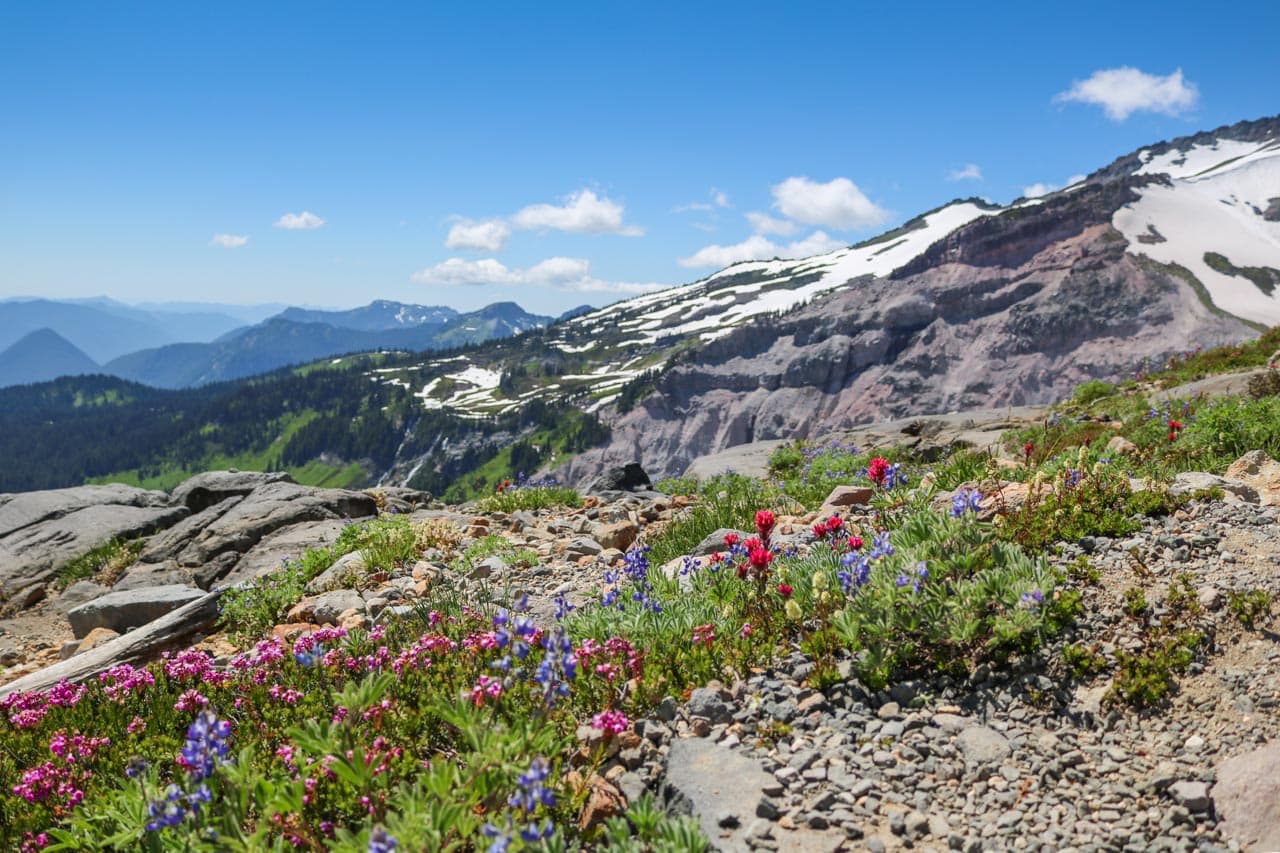
From early-July through mid-August, an abundance of wildflowers cover the slopes, ridges and valleys of Mount Rainier National Park. Once you lay eyes on this spectacle of nature, you’ll realize why this is one of the best national parks to see wildflowers.
You’ll be able to see the Mount Rainier flowers throughout the entire park, but nothing compares to the alpine meadows at Paradise.
As I’ve mentioned above, the Skyline Trail is among the best places to enjoy those summer wildflowers, one of the absolute top Mount Rainier National Park attractions.
Learn more about the beautiful wildflowers of Mount Rainier National Park here.
Photograph Mount Rainier’s Reflection in Reflection Lakes
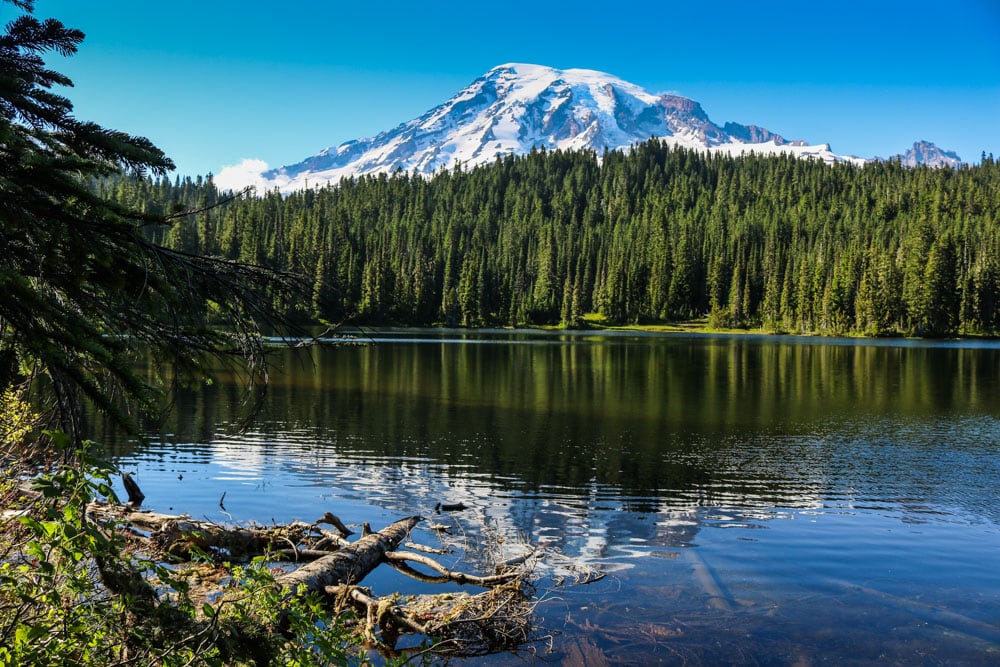
About 3 miles east of Paradise on the Stevens Canyon Road, the Reflection Lakes offer the chance to—as their name suggests—see the reflection of Mount Rainier in the water.
For this to happen, though, it needs to be a clear day. If it is, the view is amazing! You can simply park at one of the parking lots along the road and walk down to the water’s edge for prime photo ops.
Try to visit Reflection Lakes around sunrise or sunset in Mount Rainier National Park for the most serene and scenic views.
Walk Through the Grove of the Patriarchs
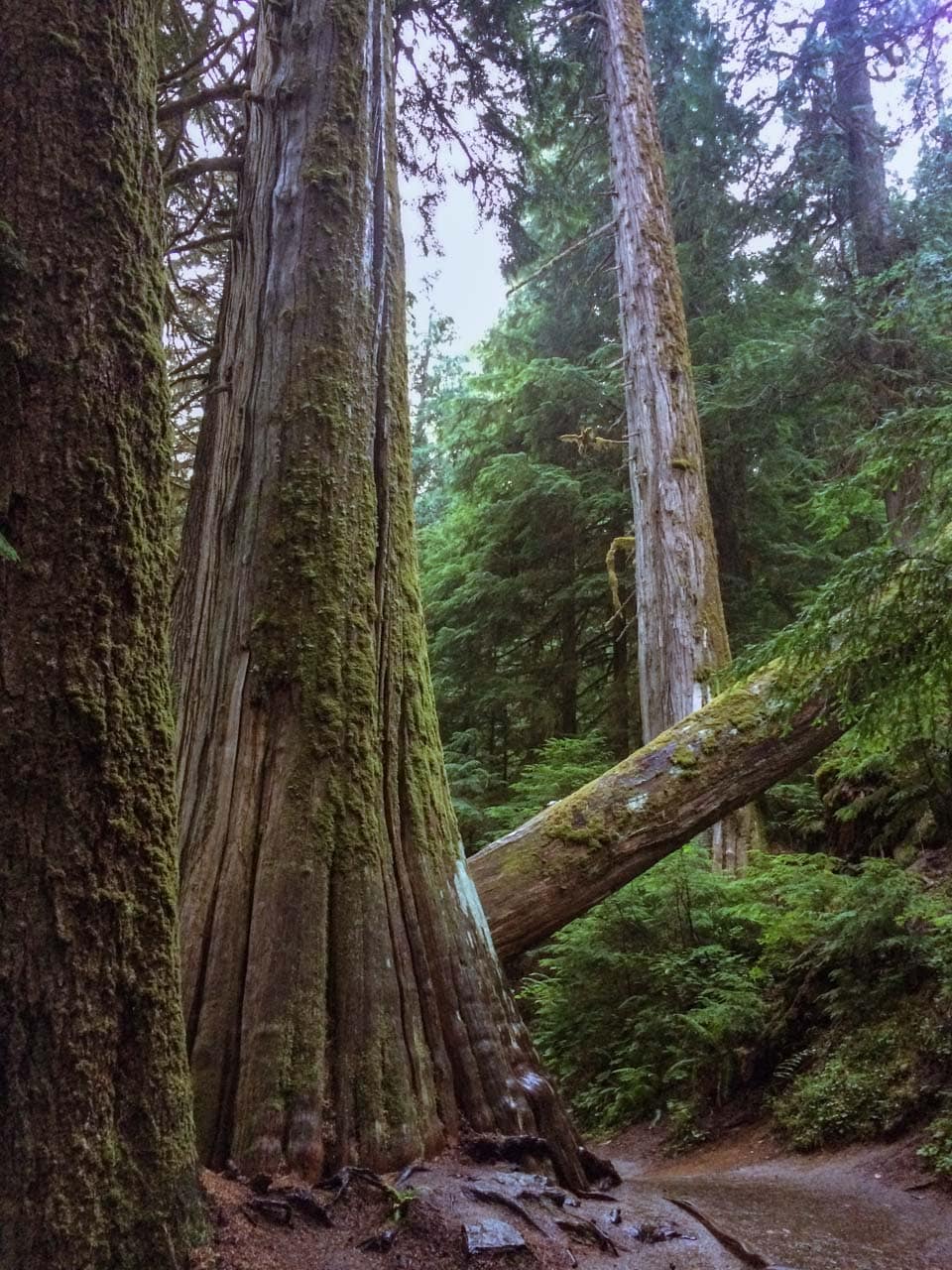
One of the most memorable things to do in Mount Rainier National Park is the short hike to the Grove of the Patriarchs. This amazing patch of ancient, towering trees is a testimony to the sheer variety of scenery in this great park.
Set on an island in a glacial river, these thousand-year-old stands of western hemlock, Douglas fir and western red cedar are super-impressive.
They’re some of the tallest and oldest trees in the Pacific Northwest, protected from forest fires thanks to their small island location.
The round-trip hike to the Grove of the Patriarchs is no longer than 1.3 miles. It’s one of the easiest hikes in Mount Rainier National Park.
Camp at the Ohanapecosh Campground
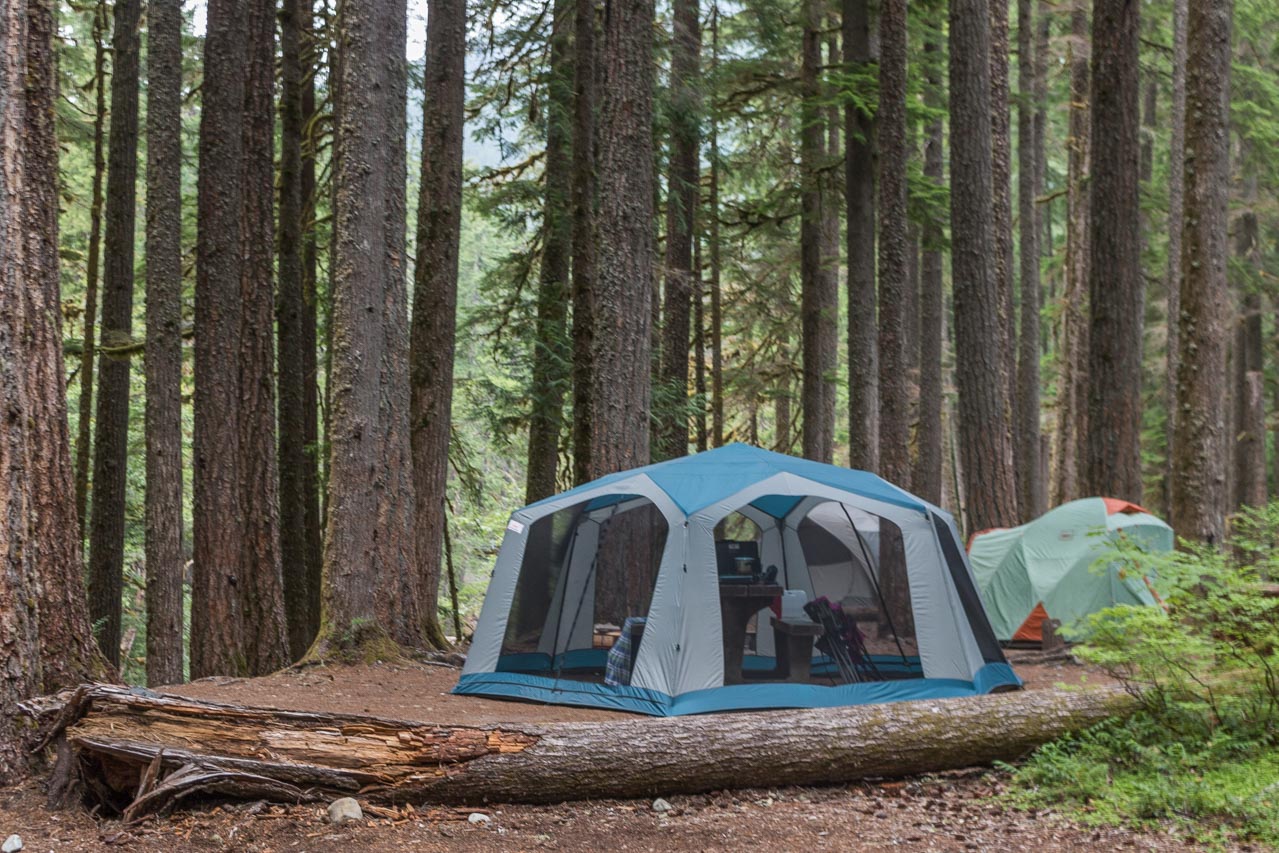
Located in the far southeastern corner of the park, the Ohanapecosh Campground is the largest campground in Mount Rainier National Park, boasting 188 campsites.
It is, however, arguably also the quietest of all three Mount Rainier campgrounds, set within a peaceful old-growth forest and bisected by bubbling mountain streams.
Many of the campsites at Ohanapecosh can be reserved in advance, but several are available on a first-come first-served basis.
I can tell you that, even if you don’t have a reservation, you’re quite likely to still find a spot here.
On my second visit to Mount Rainier National Park, I arrived in the afternoon of the second Sunday of July—the absolute peak of the summer tourist season—and there were still several non-occupied sites.
(I’d still encourage you to get there earlier or making a reservation, though. Admittedly, I was kind of stressed out about being too late for a site. Don’t recommend that!)
Enjoy Fabulous Old-Growth Forest Scenery on the Silver Falls Trail
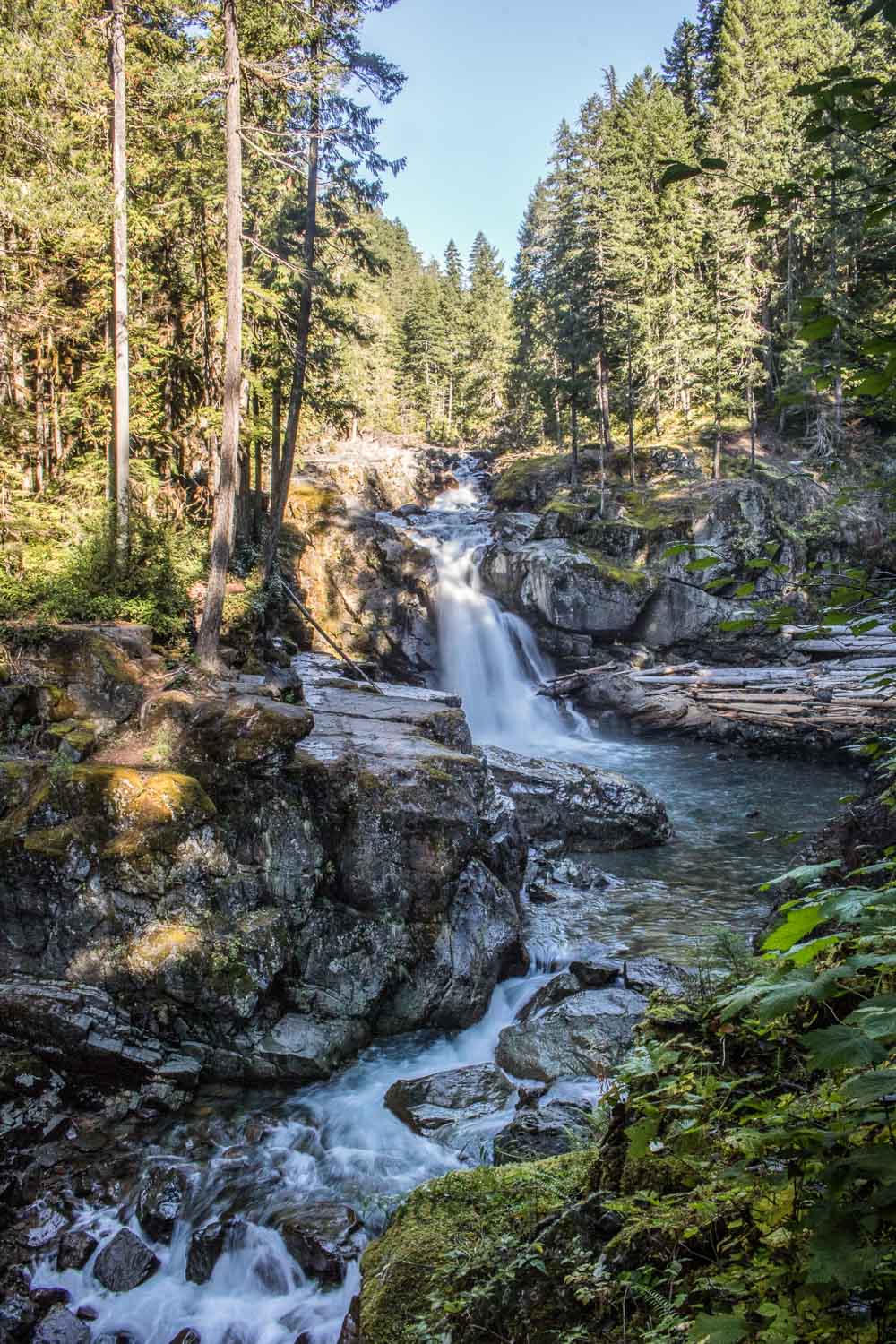
The Silver Falls Trail offers visitors the opportunity to enjoy a pleasant stroll underneath the old-growth trees along the Ohanapecosh River. On a crisp morning in summer and fall, a walk in this fragrant old-growth forest is absolutely delightful.
On the way, you can experience the bustling of life in Mount Rainier’s pristine woodlands. Listen for the tapping of woodpeckers and the rustling of deer in the bushes.
Enjoy the sounds of the crystal-clear water of the river as it tumbles down cascades and rapids.
The highlight of this wonderful and easy hike in Mount Rainier National Park is Silver Falls itself, a large 75-foot waterfall thundering down into a gorge.
The waterfall is about 1.5 miles from the trailhead at the Ohanapecosh Campground. A scenic bridge crosses the narrow gorge, making for a great photo location.
The Silver Falls Trail then runs back along the west side of the Ohanapecosh River.
Enjoy Tipsoo Lake on Chinook Pass Scenic Byway
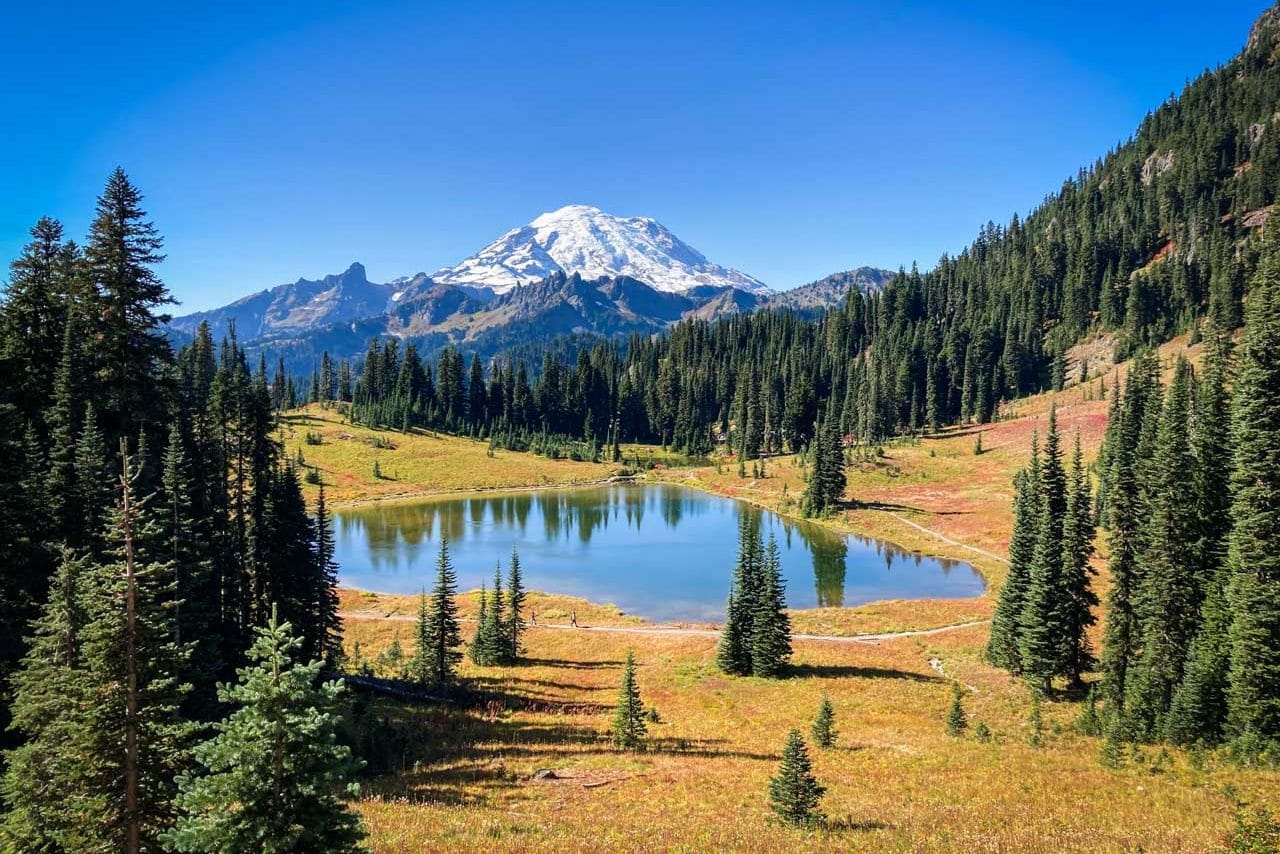
One of my favorite places in Mount Rainier National Park is Tipsoo Lake. This small and almost-impossibly beautiful subalpine lake is near the summit of beautiful Chinook Pass in the eastern part of the park.
This is another location where you can enjoy the Mount Rainier summer wildflower spectacle. The meadows and slopes around the water abound in colors in July and August.
In fall, the abundant huckleberries paint the landscape in beautiful reds and purples.
Take in the View from Sunrise Point
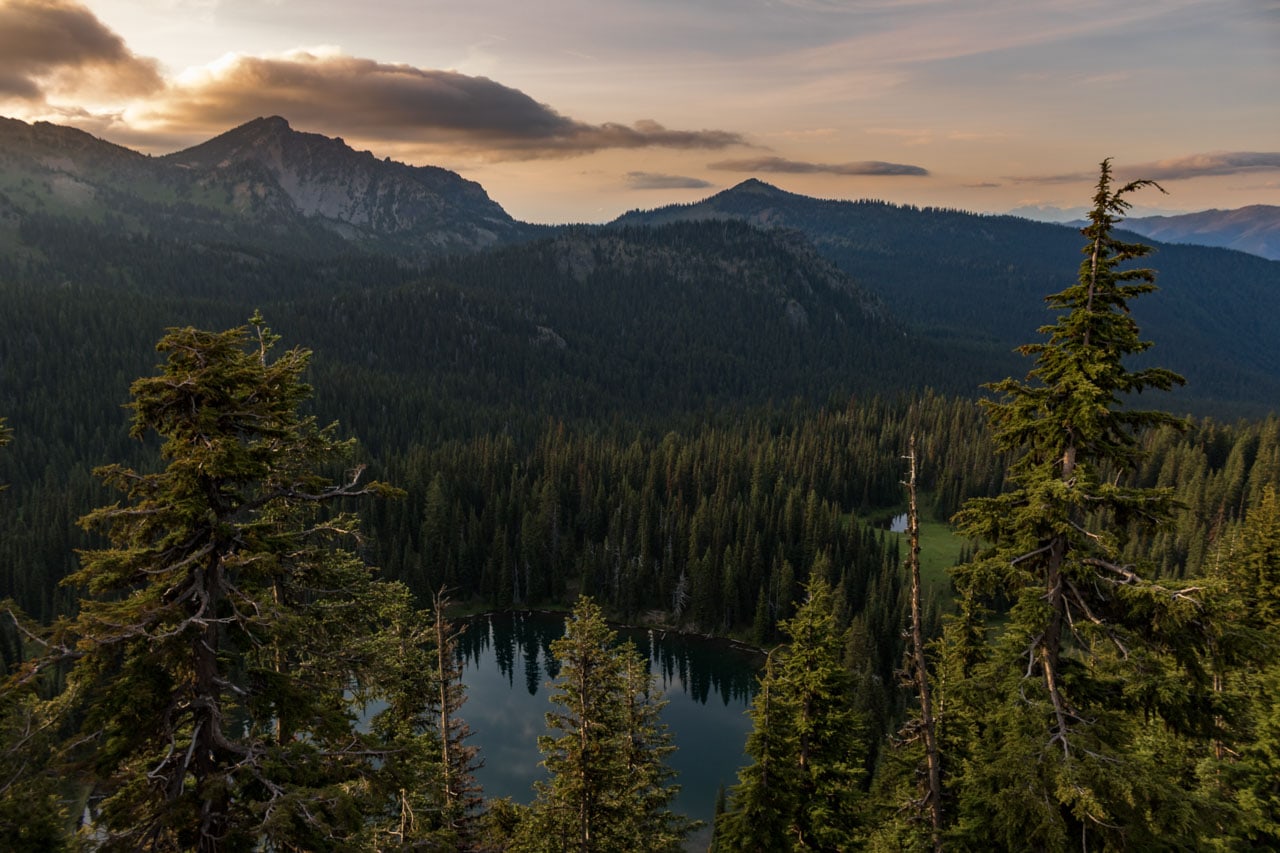
At the last switchback before the final stretch toward Sunrise, Mount Rainier’s highest vehicle-accessible point, Sunrise Point provides glorious views in all directions.
Sunrise Lake shimmers to the north, while the rugged peaks of the Cascades sweep to the east. When you look to the southwest, the enormous northeast flank of Mount Rainier blocks everything else, completing a Pacific Northwest panorama unlike any other.
Walk the Sunrise Nature Trail
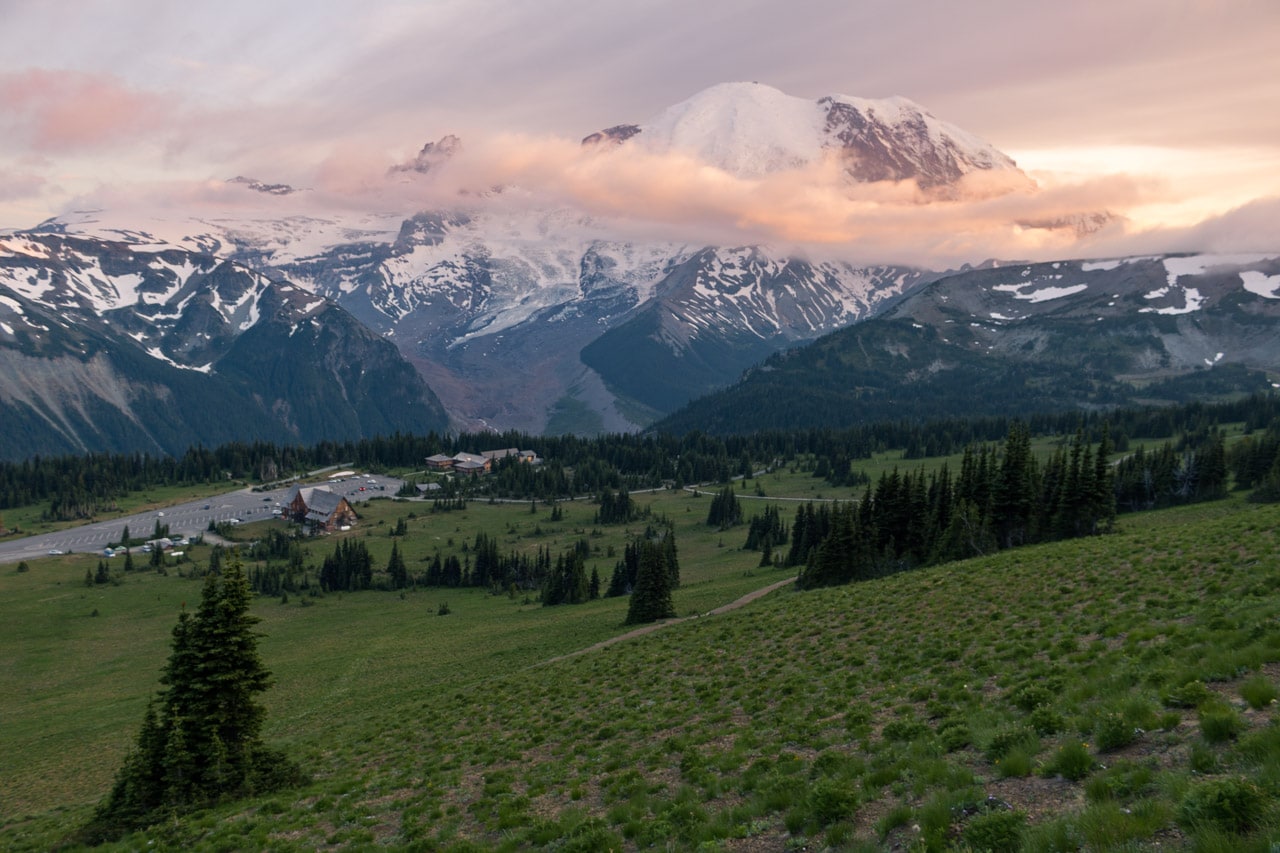
There are several awesome and challenging hiking trails in Mount Rainier’s Sunrise area, but for those of you who just want a short and scenic stroll, I highly recommend the Sunrise Nature Trail.
This self-guided 1.5-mile nature trail loops through the subalpine meadows behind the Sunrise Day Lodge. It offers some of the best views of Mount Rainier, which is so close you’ll think you can touch it, and the Cascade Mountains beyond.
Notwithstanding the name, Sunrise is absolutely spectacular at both sunrise and sunset.
Try to Spot a Rare Cascade Red Fox
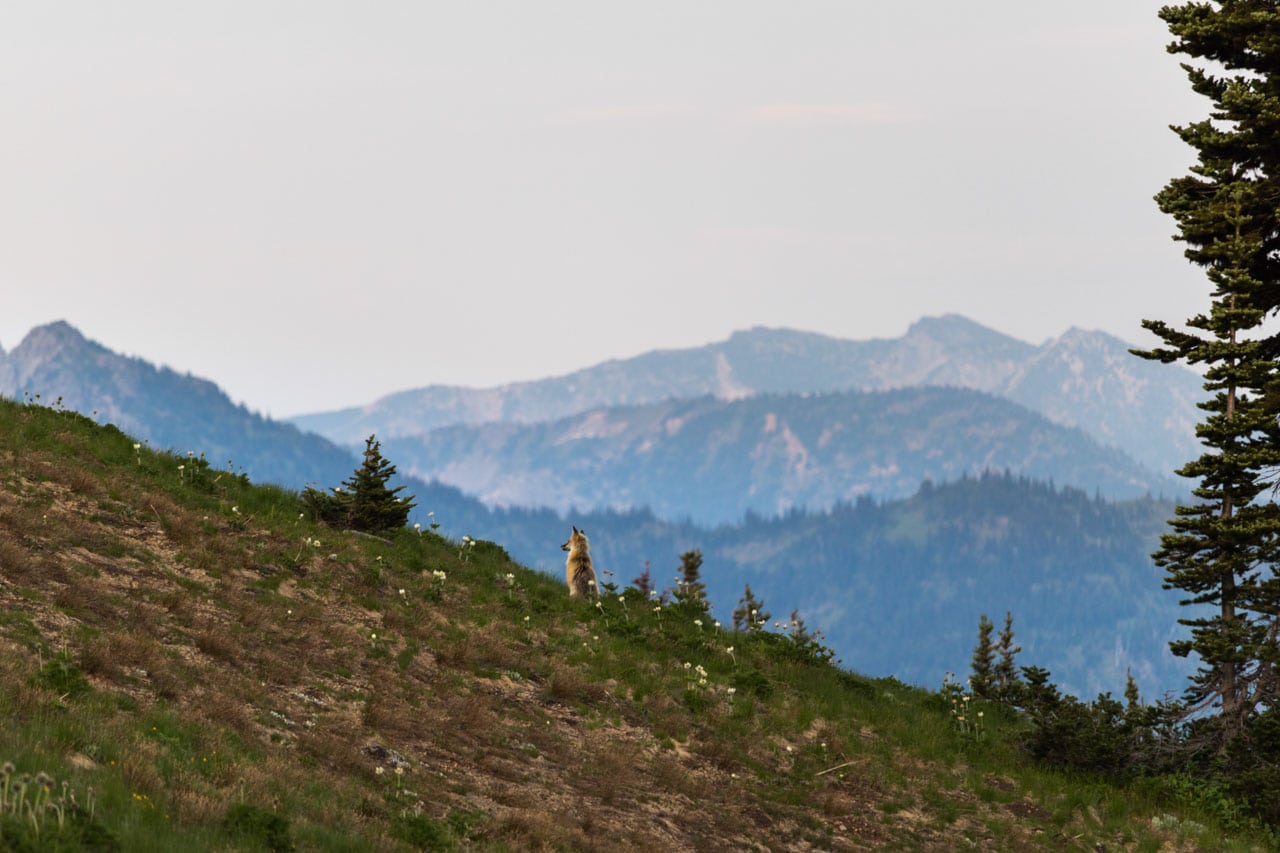
A rare subspecies of the red fox, Cascade red foxes live only the higher elevations of the Cascade Range in Washington. Fond of the subalpine parklands, upper mountain woodlands and alpine meadows of the Cascades, they aren’t found in any other U.S. state.
Although these small red foxes were once pretty widespread, the retreat of Ice Age icesheets left behind only isolated “islands of habitat in the sky” in Washington’s Cascade Range.
Nowadays, the only regions where Cascade red foxes are observed are the North Cascades (although very rarely), Gifford Pinchot National Forest and Mount Rainier National Park.
The species is a “Species of Greatest Conservation Need.”
While sightings are uncommon, it is possible to see the occasional Cascade red fox in Mount Rainier National Park.
Look for them at dawn or dusk in the park’s higher elevation areas, especially Paradise and Sunrise. I saw one myself in Sunrise’s Yakima Park late in a summer evening, after almost all other visitors had left.
Hike to Burroughs Mountain for Up-Close Views of Mount Rainier
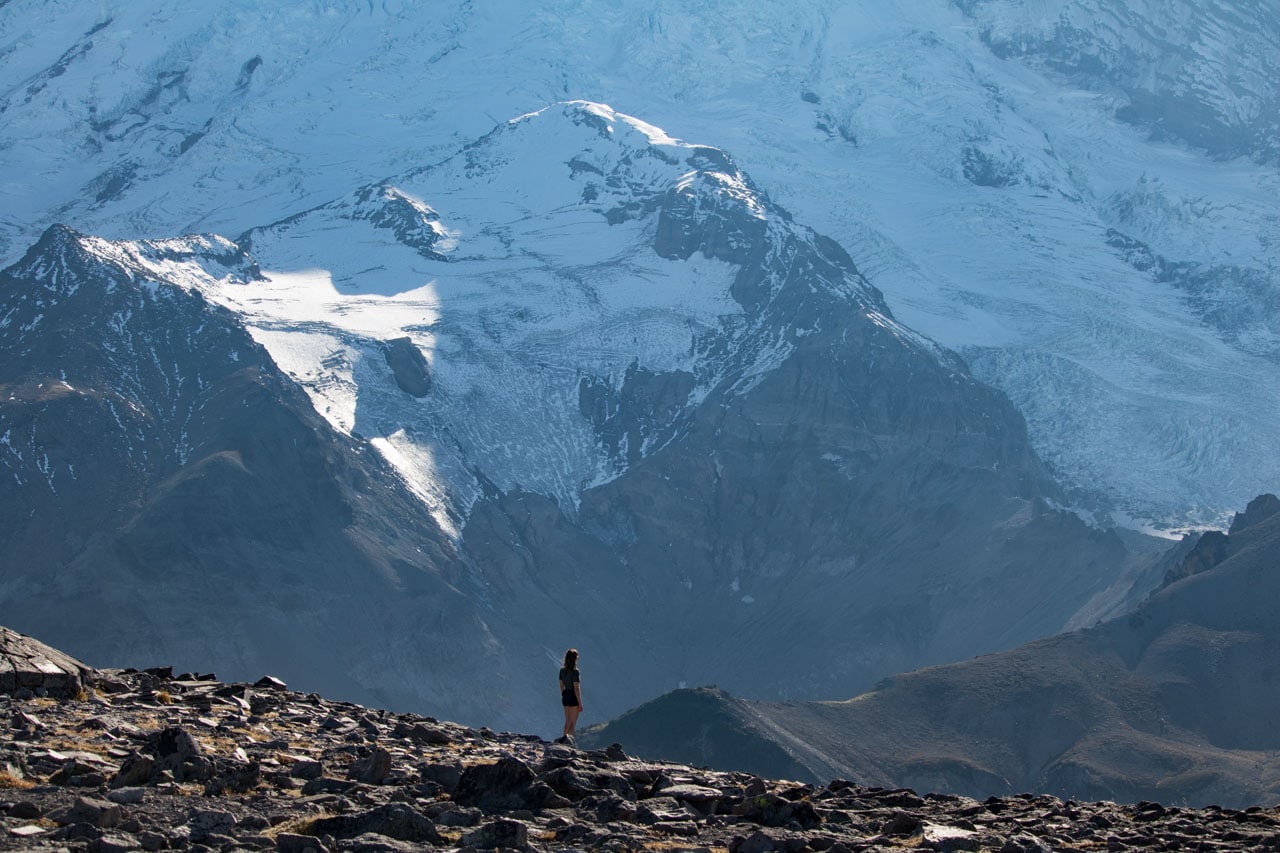
For up-close views of mighty Mount Rainier itself, few trails are better than the Burroughs Mountain Trail. Starting at the Sunrise Visitor Center, this strenuous trail is one of the best hikes in Mount Rainier to do in late-summer or early-fall.
This is because the higher elevations in this area—home to an Arctic tundra environment—are free of snow this time of year, offering access to some of the park’s highest trails.
When hiked in a counterclockwise direction, the first part of this fantastic hike is along the Sourdough Ridge Trail. Once you arrive at Frozen Lake, follow the Burroughs Mountain Trail to the top of First Burroughs Mountain.
Although the views are pretty amazing there, I encourage you to continue to Second Burroughs Mountain summit, where Mount Rainier is breathtakingly close.
Enjoy spectacular views of the gigantic Emmons Glacier, the largest glacier in the contiguous United States, and the White River. Watch for mountain goats, which are quite common here. We saw a large group of them on a slope in the distance. (These are the binoculars I use.)
You can make this a 6-mile circuit hike by taking the Sunrise Rim Trail back to the parking lot at Sunrise.
Where to Stay in Mount Rainier National Park
Mount Rainier National Park Campgrounds
There are three developed campgrounds in Mount Rainier National Park, all of which are a great base for the things to do in Mount Rainier National Park mentioned above.
A fourth campground, at Mowich Lake, is primitive, free and accessible only via a rather rough dirt road. Since this campground is far removed from any of this post’s Mount Rainier National Park activities, I’ve not included it here.
- Cougar Rock
- Between Longmire and Paradise
- 3,180 feet elevation
- 173 sites
- Open from late-May to late-September
- Advance reservations possible, some first-come first-served sites available too
- Ohanapecosh
- Ohanapecosh area in the southeast of the park
- 1,914 feet elevation
- 188 sites
- Open from May to late-September
- Advance reservations possible, some first-come first-served sites available too
- White River
- Along the Sunrise Road
- 4,400 feet elevation
- 112 sites
- Open from late-June to late-September
- First-come first-served
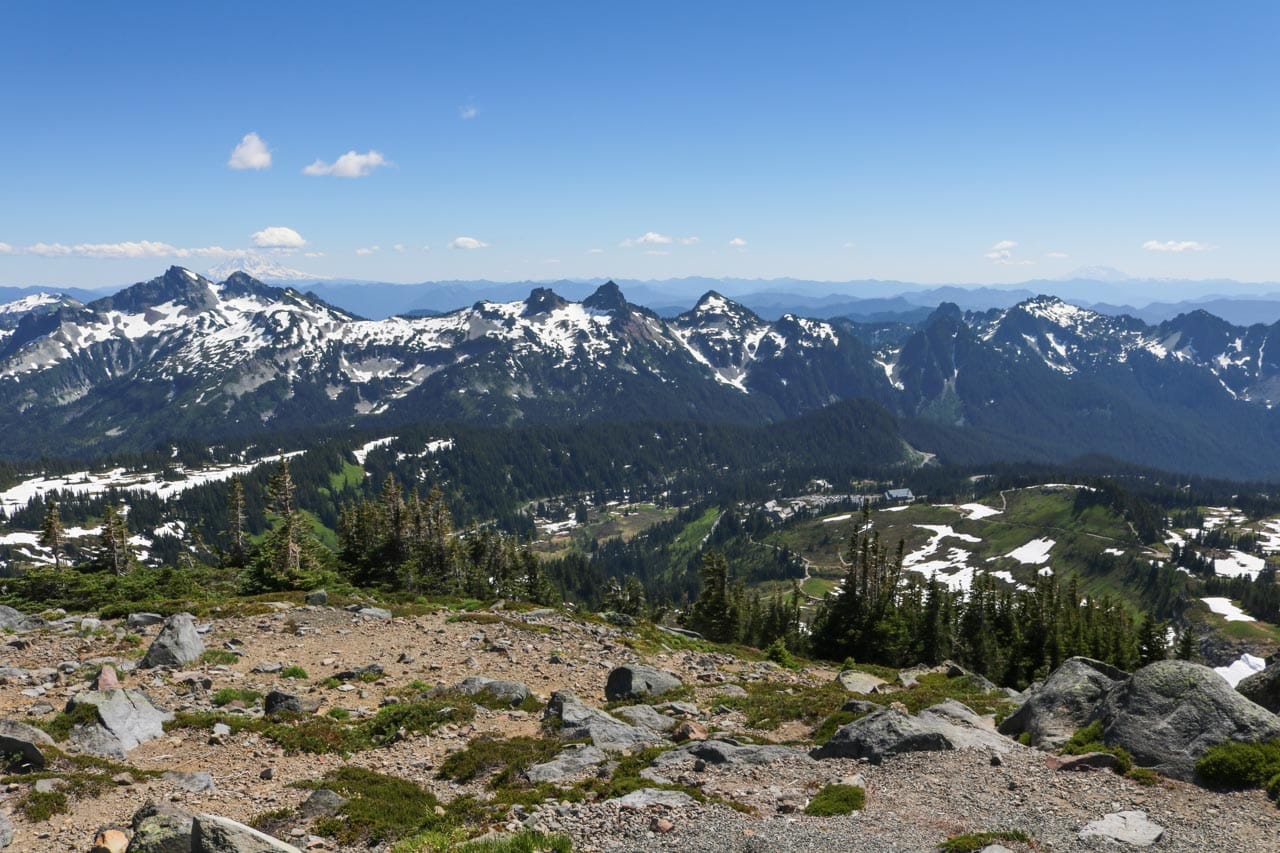
Mount Rainier National Park Lodges
You can find some more luxurious accommodation in Mount Rainier National Park at two locations. Both are in the southern part of the park.
- National Park Inn
- Longmire Historic District
- 25 guest rooms, dining room and general store
- Open year round
- More information
- Paradise Inn
- Paradise
- 121 guest rooms, dining room, café, gift shop and post office
- Usually open from mid-May to early-October
- One of the greatest national park buildings in America
- More information
Accommodation Near Mount Rainier National Park
There are only a couple of towns just outside of the Mount Rainier National Park boundaries. They’ll have various accommodation options, grocery stores, cafés, internet access and even a brewery.
The two main towns outside this Washington State national park are Ashford and Packwood, respectively near the southwestern Nisqually Entrance and the southeastern Ohanapecosh Entrance. (See the Mount Rainier National Park map below.)
Wildlife Safety at Mount Rainier
The sheer variety of landscapes, life zones and habitats in Mount Rainier National Park make the park a wildlife haven.
Often-spotted animals include Douglas squirrels, black-tailed deer, chipmunks, hoary marmots, common ravens and Stellar’s jays. But there are many other animals that call Mount Rainier home, too.
More than 180 species of birds, 5 reptiles and 65 mammal species live in the park, along with 14 kinds of amphibians and 14 fish species. Most of them, you won’t see during your time in Mount Rainier National Park, but remember that they are around. You’re never alone in this park!
Lucky visitors might see a black bear on the forest edge, a herd of elk grazing in the alpine meadows, or a rare Cascade red fox running down a slope.
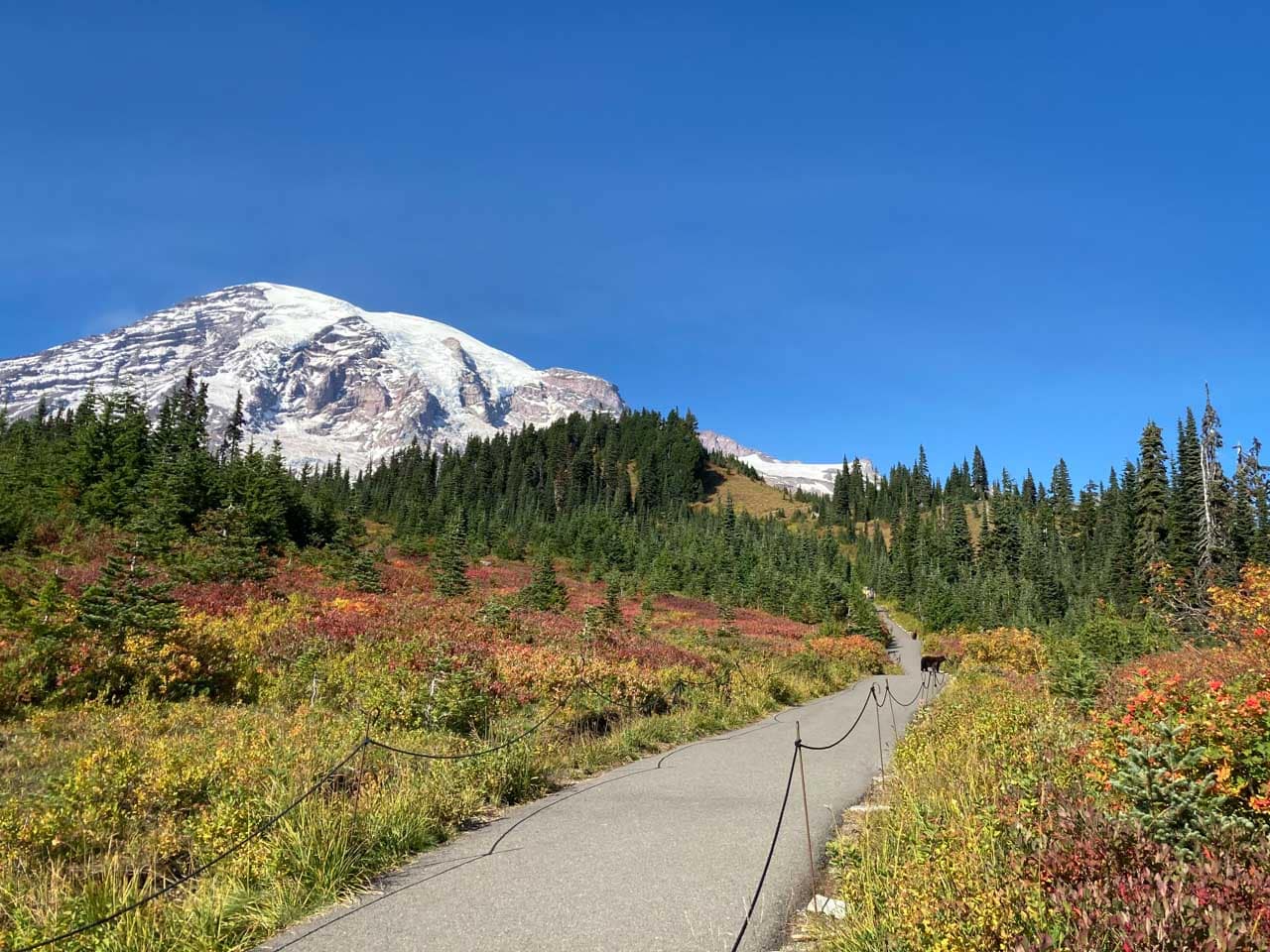
Mountain goats are also among the high-profile wildlife in Mount Rainier National Park, but they tend to stay at higher elevations.
Besides black bears and red foxes, Mount Rainier is also home to another carnivore: the mountain lion or cougar. These elusive animals prefer remote woodland areas, though, and are seldom seen.
If you do run into a black bear or mountain lion while hiking in Mount Rainier National Park, however, you should know how to behave:
Note that, although they’re herbivores and may seem calm, gentle and friendly, both elk and mountain goats can be dangerous, too. Always keep your distance from all wild animals in Mount Rainier National Park!
Note: Unlike Washington’s North Cascades National Park, which has a tiny population of them, there are no grizzly bears in Mount Rainier National Park. Additionally, you also don’t have to worry about rattlesnakes in this park.
Attractions & Activities in Other West Coast National Parks
- Crater Lake National Park Attractions
- Death Valley National Park Attractions
- Joshua Tree National Park Attractions
- Lassen Volcanic National Park Attractions
- North Cascades National Park Attractions
- Olympic National Park Attractions
- Olympic National Park Quinault Valley Attractions
- Redwood National Park Attractions

